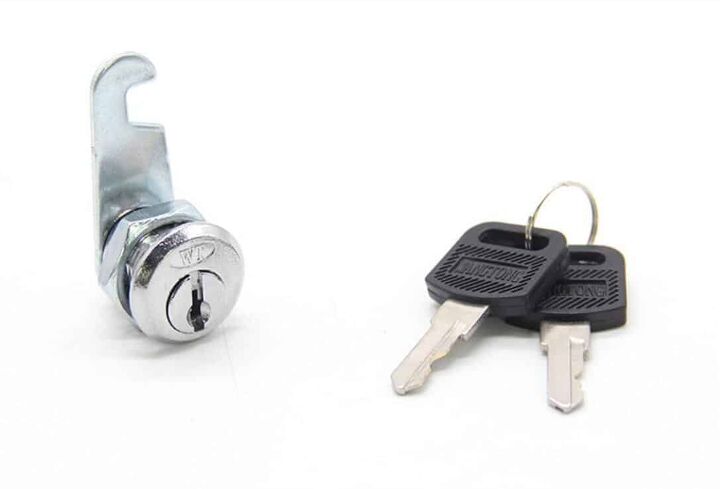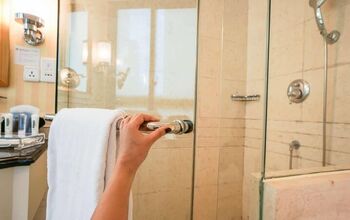17+ Types of Door Locks (with Photos)

With around 2.5 million homes being broken into each year, door locks are essential to the safety and security of your home or business. They serve as a barrier, keeping your property, family, and belongings safe while also maintaining privacy. Whether you want to lock a front door, cabinet door, or pocket door, the efficacy of the locking system you choose is of the utmost importance.
When you visit your local hardware store, you’ll notice many different types, sizes, shapes, and styles of door locks, which can make it difficult to determine what door lock to choose. Some of the most common options include knob locks, deadbolt locks, cylindrical lever locks, sliding door locks, padlocks, and even the more sophisticated electronic, smart, and fingerprint door locks. Understanding the various types of door locks available can help you make an informed decision about which is best for your purposes.
17+ Types of Door Locks
Our comprehensive guide on door locks will help you understand the distinctions between the different types so you can find the right one for the internal and external doors in your home.
1. Knob Locks
Beginning with the most common type of door lock, knob locks are often seen on doors that lead to the outside. They are used by nearly everyone to lock up their home or business on a daily basis. The distinguishing feature of this type of knob lock is that the lock cylinder is located inside of the knob, rather than inside of the door. While many choose to use these locks on both interior and exterior doors, they are best used indoors as they don’t provide as much security as many other types of exterior locks.
When a knob lock is placed on an exterior door, it creates a situation where your home can easily be broken into. Because of this, knob locks on a front door are often seen paired with a deadbolt or another, more secure, type of lock. Knob locks feature knobs on both sides of the door, and may have either a single or double cylinder depending on whether or not you also want to be able to lock the door from the inside.
Knob locks date back to the 1800s, with the first patent given to Osborn Dorsey, an African American inventor, in 1878. He created a doorknob with an internal door-latching system. Although, in 1818, three locksmiths in Britain developed the design or the tumbler lock, which the knob locks of today are based on.
2. Deadbolt Locks
Deadbolt locks are, undeniably, the most popular type of exterior door lock and are commonly used on the exterior doors of residential properties. Though, commercial property owners also use deadbolt locks to ensure safety and security for their businesses and facilities. Deadbolt locks are a mechanism that is separate from the door knob, adding an extra layer of security to entry doors. They reduce the risk of unwanted entry by creating a secure locking system that makes it virtually impossible for intruders to break down the door.
These locks offer maximum security for your front door. They are designed to provide extra security for exterior doors and to be used in combination with a door knob lock or lever lock. Most exterior doors are pre-drilled to fit deadbolts, which makes installation a breeze. Deadbolt locks come in single- and double-cylinder models.
The deadbolt lock got its name from the fact that it does not feature any internal spring-loaded mechanisms like other bolts – for all intents and purposes, the lock is “dead.” These locks can be traced back to the 1800s, when banks started using locks that required keys on their safes.
3. Handleset Locks
Handleset locks consist of a handle on the exterior side of the door and either a twist knob or keyed opening on the interior side for locking the door. To open the door from the outside, this type of lock requires you to press down on a thumb latch, instead of simply twisting the knob like you would with a traditional knob lock.
For additional security, this type of lock features a deadbolt instead of a traditional spring bolt. These types of locks serve an identical purpose as knob locks, while offering a more visually appealing look. Handleset locks can be single cylinder (with one exterior keyhole) double cylinder (with both an interior and exterior keyhole), electronic, or even smart (with the ability to connect to your smartphone).
4. Hand Levers
Hand levers are an ideal choice for interior doors, such as basement doors and closet doors. They consist of a simple lever handle on one side and a twist knob on the opposing side. When compared to other types of locks, hand levers offer little security. However, they make it quick, easy, and efficient, to open doors with one hand – a feature that can be incredibly useful when your hands are full with groceries or laundry.
5. Barrel Bolt
Also referred to as a sliding bolt, barrel bolts often go inside of an exterior door to provide additional safety for your home and family. The lock is comprised of two main components: one that is installed on the door frame and the main locking assembly that is mounted on the door. The main locking assembly features a cylindrical lock that can be slid in and out of the catch from the inside.
By sliding the lock into the catch, you are locking the door. For maximum security, many choose to install barrel bolts both on the top and bottom of a door.
6. Chain Lock
Commonly found on the inside of hotel room doors, chain locks feature a catch on the door frame and a primary locking assembly on the door itself. These locks are designed similarly to barrel bolts, except for the fact that they use a chain to lock the door instead of a cylindrical lock.
The idea behind the chain lock is that it allows you to open the door a little bit to greet someone, while still keeping the door locked and closed. The guest cannot enter until you close the door, release the chain, and then reopen the door all the way. It offers just enough security to peek out the door without any risk of someone barging in.
7. Mortise Locks
Mortise locks are incredibly powerful and, like deadbolts, are typically used on exterior doors. While they are most often seen on commercial properties, they can be used on residential homes provided that they have enough space for them to operate. Mortise locks have in use since the eighteenth century, with earlier versions featuring a pull to unlock the door. Eventually, this pull was replaced with a doorknob.
These locks are comprised of an internal system which categorizes them more as locksets, rather than just locks. They can house either levers or knobs and often feature a cylindrical body. Mortise locks are threaded, utilizing mortise components added inside of the door. A box lock is placed within the mortise, which refers to a deep recess in the edge of the door. These locksets remain secure by using a set screw and a cam, which forms the locking mechanism. The cylindrical component comes in a range of lengths and heights, depending on the type of door.
This type of lock is very strong, which is why many business owners prefer to use mortise locks over any other type. They are on par with deadbolt locks in terms of strength and durability, though many consider mortise locks to be more reliable than their deadbolt counterparts.
8. Euro Cylinder Locks
More often seen in Europe rather than the United States, Euro cylinder locks are typically used on patio doors and interior double doors. Also called a pin tumbler lock, Euro cylinder locks are the most popular locking system used by locksmiths and architectural ironmongers. They are primarily used as the locking mechanism for operating a lock case.
There are three different euro cylinder locking options: The single cylinder, which can be locked from only one side; the double-ended cylinder, which lets you lock the door from either side; and the key and thumb turn model, which uses a key to lock on the outside and a thumb turn on the inside. Euro cylinder locks come in a wide variety of lengths to fit varying door thicknesses.
Standard versions of this type of lock can be easily broken, especially when the cylinder protrudes from the surface of the door. For best results, the cylinder should be flush with the door or slightly sunken in. The design of the standard lock also makes it vulnerable to snapping in the center. However, high-security anti-snap models have been developed to remedy this problem.
9. Electronic Door Locks
Electronic looks do not require physical keys to lock or unlock them. Instead, they feature a card or keypad system in which you’ll have to use special key or card in order to operate them. In most cases, these types of locks lock the door automatically. You’ll typically find electronic locks on offices, hotel rooms, and schools, though, many homeowners are starting to opt for them as well.
If your particular electronic lock operates off of electricity, this can become an issue when the electricity goes out. As such, it’s important that you have a backup plan that allows you to still operate your door. Depending on the electronic lock model, it may also be equipped with a combination key system that allows you to use a regular key if you lose your card key or forget your special code. These types of locks usually function on batteries that have an incredibly long lifespan.
10. Smart Locks
Smart locks are the most recent type of door lock to hit the market. With these locks, your smartphone serves as the key, providing remote access to your home from pretty much anywhere in the world. Oftentimes, smart locks are much more than locks. Many smart locks are an entire system of audio and video monitoring and additional smart features that gives you full control over the security of your home.
Like electronic locks, most smart locks will also have a keyhole to use in the event that you’re not connected to the app. The three main types of smart door locks are as follows:
Wi-Fi Smart Locks
With Wi-Fi smart lock systems, you can control your device from anywhere provided that you are connected to the internet. Even if you’re not home, you can let someone into your house from the convenience of your smartphone. When compared to other types of smart locks, Wi-Fi systems tend to drain the batteries much faster. As such, you may have to replace the batteries in your lock about every month.
Bluetooth Smart Locks
Bluetooth smart lock systems, on the other hand, do not drain the batteries as quickly. In fact, this is currently the most common connection used for smart locks. These types of locks connect directly to your smartphone and do not require any sort of hub to facilitate the connection. When you’re within range, you can unlock or lock your door using your Bluetooth device.
The drawback to Bluetooth smart locks is the fact that you cannot control the lock when you’re out of range. Therefore, if you want to be able to operate your doors when you’re away from home, you may want to consider a different option.
Z-Wave Smart Locks
Z-Wave smart locks require a hub that you must connect to in order to operate the lock using your internet-connected mobile device. This type of smart lock is essentially a combination of Wi-Fi and Bluetooth locks. The smart lock must be within a specific range of the hub in order for it to work. If you cannot place the hub within an acceptable range, signal range extenders can be implemented to help strengthen the signal.
11. Fingerprint and Retinal Scan Door Locks
One of the most convenient options simply because they don’t require a key to operate, fingerprint door locks provide a more state-of-the-art level of security since only those who have their fingerprint programmed can open the lock. To operate a fingerprint lock, you have to place your forefinger flat against the sensor that recognizes the fingerprint pattern.
Retinal scan door locks, on the other hand, sound like something straight out of a science fiction movie. They are the most advanced form of exterior door lock and are mostly used to secure buildings that house important manufacturing, governmental, and medical items. These locks require users to enter a biometric scan of their retina in order to gain entry. The real-time retina scan must match what is programmed into the system.
12. Sliding Door Locks
Sliding glass is often seen as easy targets for burglars. The factory locks that come with standard sliding glass doors simply don’t provide the level of security needed to protect your home from robbery. Homeowners who have these kinds of doors on the exterior of their home should strongly consider replacing the factory-installed locks with either two-bolt locks or smart locks that are designed specifically for these doors.
Two-bolt locks slide a steel bolt into door frames, effectively strengthening the frame. Whereas, a smart lock be used to open and close the door remotely. Sliding door locks can add additional security to your existing exterior sliding doors. They are cost-effective, easy to install, and available in a wide variety of styles to coordinate with your current décor.
13. Padlocks
Padlocks are one of the most basic forms of door locks. They’ve been around for years and are arguably the most recognized type of lock. The applications that padlocks can be used for are virtually endless including locking sheds, securing bicycles, locking a garage door, and adding additional security to homes and businesses.
Instead of being attached to something else, padlocks lock into themselves. They may be small or larger, and are typically rectangular or square in shape with a U-shaped bar at the top. One side of the bar always remains in the lock, while the other side moves in and out, to secure and release the lock.
14. Cam Locks
Cam locks are typically found in mailboxes, filing cabinets, low-security bank deposit boxes, and lockers. These fasteners allow storage to be kept intact in a latent way, without impacting the overall appearance. For the most part, cam locks are virtually invisible and, as such, you’ll see them in fully constructed cabinets and sets of furniture.
These door locks are cylindrical and are positioned in the wooden part of the door. A metal tube with a hole in one side helps to position the bolt when inserted. Cam locks are essentially simplified versions of other locks, requiring a key to turn a cam – which unlocks or locks the device. They may be tubular or flat, with keys in a corresponding shape that is sufficient to open them.
15. Electric Strike Locks
Electric strike locks or electric strikes are electromechanical door locking systems, which means they are mechanical locks with electronic devices. These types of locks are used in combination with another type of locking device, like a panic bar or lock set. They are installed in place of the traditional lock strike plate on the interior of the door frame. When electrical power is supplied to the strike, the latch or lock bolt is held in place.
This keeps the door locked until the release system is initiated. The release system used will depend on the application. Some types of release systems include a keypad that requires a passcode, reception release buttons, fob readers, and electronic key card readers. When the release system is activated, a hinged piece of metal inside of the electric strike pivots, allowing the door to open without having to turn the handle.
The lock set or panic bar functions separately from the electric strike. This means that although the electric strike plate works to keep the door locked from the outside, even if the power goes out, the door can still be opened from the inside by either turning the handle or pressing the touchpad on the panic hardware. Depending on the specific application, can usually be either fail-safe or fail-secure by operating an integral switch.
Fail-Secure Locks
Electric strike locks require an electric current of at least 12 volts or higher in order to operate properly. These types of locks are traditionally fail-secure, meaning they require power to unlock the door and if power is lost, the door will remain locked. This means that doors will stay locked even in the event of a power outage. However, doors with fail-secure locks will also have knobs in order to open the door from the inside.
Fail-Safe Locks
Put simply, fail-safe locks require power in order to lock the door. If the power is lost for whatever reason, the door will become unlocked. When using this type of locking system in your home or business, it’s important that you have some type of back-up power to ensure safety and security of your property. Magnetic locks are considered fail-safe locks.
16. Magnetic Locks
On the other hand, magnetic or “mag” locks are electromagnetic door locking mechanisms. These locks feature a large electromagnet that is installed along the top of the door frame, along with a metal plate on the door that lines up with the magnet. The lock works by passing an electric current through the electromagnet, which creates a magnetic charge that attracts the plate and holds it in position against the door frame. This will keep the door locked until power is removed or interrupted.
Release systems from magnetic locks include many of the same types used for electric strikes. When energized, a magnetic lock can generate a retention force greater than 1,000 pounds – yielding an incredibly effective lock. Of course, only until the power goes out. By design, mag locks require a constant supply of electricity in order to remain locked, meaning they are fail-safe only. When the power is out, mag locks will not keep the door locked from either side.
17. Child Proof Door Locks
Also called child safety locks, child proof locks are a distinctive type of lock that can be used on a range of doors in your home to help keep your kids out. They aren’t primarily used for security, but rather more for the safety of young children who could get harmed by the contents of your cabinets, refrigerator, or other items throughout your house.
Believe it or not, the leading cause of death among children is accidental injury. Child proof locks can help keep food, medicine, and other potentially hazardous items out of reach of your young children. Additionally, some child safety locks can help keep your kids away from unsafe stairs or out of your closets. Here are some of the most common types of child safety locks available:
Door Top Locks
Top locks on doors are positioned high enough that they are out of reach of children. These types of child safety locks are excellent options for parents with kids who know how to open baby gates or get around other child-proofing systems. They are installed at the very top of a door and a hanging latch must be pulled in order to unlock. The door can be unlocked from either side, which prevents accidental lock outs.
Cabinet Locks
Child locks for cabinet doors can be installed on either the inside of the door or around the handles to prevent opening. The most common form of cabinet lock is the inner-door lock, which mounts to the top of the inner portion of the cabinet and hooks to a piece that is installed on the door, or vice versa.
When installed, the door opens just enough to allow you to press down on the lock and free the hook from the receiving end.
Refrigerator Door Locks
Although there are many different types of locks that can be used to secure your refrigerator door, the most common variation is the button lock. This lock features one side with a button attached to the refrigerator door that clasps to the hook on the other side, which is mounted onto the refrigerator itself. To release the clasp and open the door, all the parents have to do is press down on the button.
Oven Door Locks
Oven door locks are commonly used by parents to keep small children from lifting themselves up using the oven door or opening it out of curiosity when in use to reduce the risk of injuries and severe burns. The most common form of lock that is used on oven doors does not require drilling, but is attached using two adhesive pieces. One piece is attached to the locking piece and the other is detached.
One connects to the oven door, while the other attaches to the oven itself. A small lock grips the detached button-like part in order to lock and then is flipped up to unlock the door. This type of lock can also be used on refrigerators, cabinets, drawers, and more.
Lock Grades and Ratings
When you’re shopping for the right type of door lock and handle, you also want to factor in the lock’s grade. Most lock manufacturers put their products through testing by the American National Standards Institute (ANSI) and Builders Hardware Manufacturers Association (BHMA) for grading based on performance. The locks are tested based on strength, operation, security, finish, material evaluation, and cycle.
Lock grade refers to the number of lock/unlock cycles the lock will complete before it wears out. It is a direct indication of the durability of the internal door lock mechanism, not necessarily the security it provides.
- Grade 1: 800,000 cycles
- Grade 2: 400,000 cycles
- Grade 3: 200,000 cycles
Locks that are categorized as Grade 1 offer the maximum amount of strength and security, followed by Grade 2 and Grade 3:

Jessica considers herself a home improvement and design enthusiast. She grew up surrounded by constant home improvement projects and owes most of what she knows to helping her dad renovate her childhood home. Being a Los Angeles resident, Jessica spends a lot of her time looking for her next DIY project and sharing her love for home design.
More by Jessica Stone




























